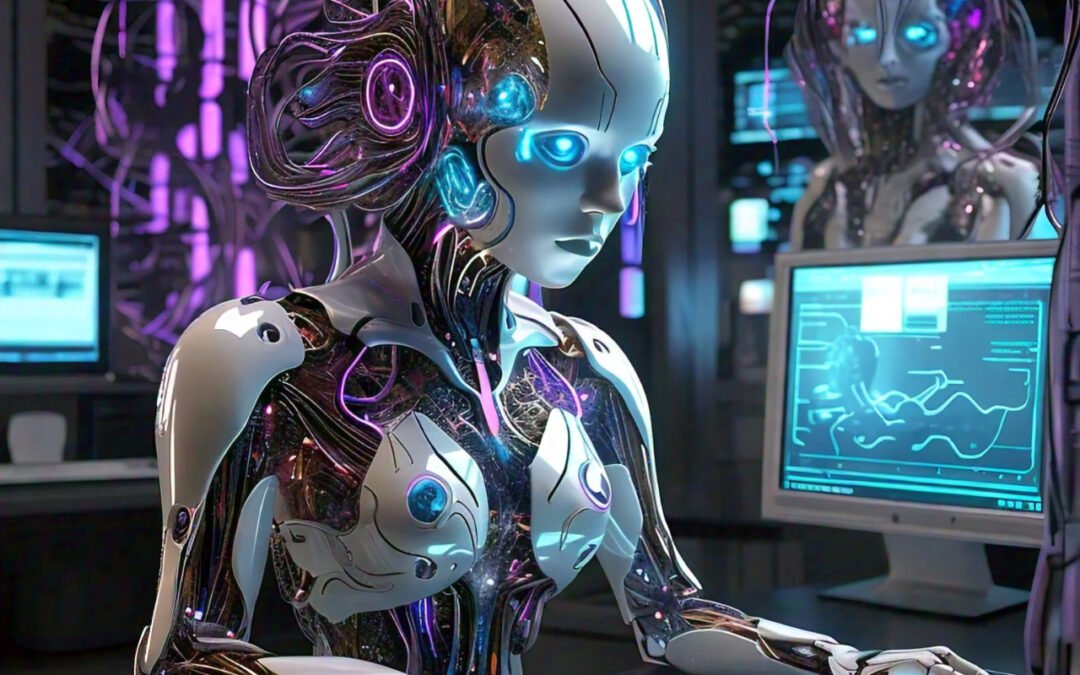AI-Powered Autonomous Agents: Revolutionizing Task Automation and Decision-Making
The concept of autonomous agents—AI systems capable of performing tasks, making decisions, and interacting with environments with minimal human oversight—has long been a vision in science fiction. Now, with advancements in artificial intelligence, that vision is rapidly becoming a reality.
Autonomous AI agents are equipped with sophisticated decision-making capabilities, enabling them to operate independently across various settings, from customer service to manufacturing and even complex scientific research.
In this article, we’ll explore the development of AI-powered autonomous agents, the underlying technologies that empower them, their applications across industries, and the benefits and challenges associated with their adoption.
Understanding AI-Powered Autonomous Agents
Autonomous agents are systems designed to perform tasks, make decisions, and navigate dynamic environments independently. They can adjust their actions based on real-time data and respond to changes in their environment, giving them a high degree of operational flexibility and independence. Unlike traditional AI models, which are often reactive and single-purpose, autonomous agents are proactive, adaptable, and capable of continuous learning.
Key features that define AI-powered autonomous agents include:
- Task Automation: Automating complex or repetitive tasks without human intervention.
- Decision-Making: Using data and pre-defined rules or policies to make informed decisions.
- Environmental Interaction: Sensing and adapting to changing conditions in real-time.
- Continuous Learning: Improving over time based on new data, feedback, and experiences.
The Technology Behind Autonomous Agents
The functionality of autonomous agents is made possible through a combination of several advanced AI technologies:
- Reinforcement Learning (RL)
- RL is a machine learning technique where agents learn optimal behaviors by receiving rewards or penalties based on their actions. Over time, the agent develops strategies to maximize rewards, allowing it to make decisions in unfamiliar scenarios.
- Autonomous agents use RL to refine their actions based on successes and failures, learning from their interactions with the environment.
- Natural Language Processing (NLP)
- NLP enables agents to understand and generate human language, facilitating interactions with people and enabling conversational interfaces.
- NLP is especially useful in customer service bots and virtual assistants, where agents need to understand user intent and respond accurately.
- Computer Vision (CV)
- Computer vision allows agents to interpret and analyze visual information, enabling them to understand physical surroundings or recognize objects.
- This technology is essential for autonomous agents in robotics, manufacturing, and logistics, where visual data is used to navigate spaces or inspect objects.
- Multi-Agent Systems (MAS)
- Multi-agent systems involve multiple autonomous agents working collaboratively. They can communicate, coordinate, and negotiate with each other to achieve complex tasks.
- MAS is particularly relevant in logistics, swarm robotics, and resource management, where agents need to collaborate to achieve a common goal.
- Edge Computing
- Edge computing reduces latency by processing data closer to where it is generated, enabling real-time decision-making.
- For autonomous agents, particularly in robotics and IoT, edge computing allows faster responses to environmental changes without relying solely on cloud connectivity.
Applications of AI-Powered Autonomous Agents
AI-powered autonomous agents have broad applications across various sectors, providing value through automation, efficiency, and scalability.
- Customer Service and Support
- Autonomous agents are used in customer service to handle inquiries, assist with troubleshooting, and provide personalized recommendations without human involvement.
- They enhance customer experiences by providing 24/7 support, often through AI chatbots or virtual assistants capable of understanding user sentiment and context.
- Manufacturing and Industrial Automation
- In manufacturing, autonomous robots equipped with sensors and computer vision are used to inspect products, perform quality control, and operate machinery.
- These agents reduce errors, improve production speed, and maintain consistency, which is particularly beneficial in high-precision industries like electronics and automotive manufacturing.
- Logistics and Supply Chain Management
- Autonomous agents are used for warehouse management, inventory tracking, and route optimization in logistics and supply chain operations.
- Autonomous drones and robots assist in picking and packing orders, while decision-making algorithms optimize routes to minimize delivery times and costs.
- Healthcare and Medical Assistance
- Autonomous agents assist in patient monitoring, drug discovery, and medical imaging, where they analyze data, detect patterns, and recommend treatments.
- In hospitals, autonomous robots can deliver supplies, monitor patients’ vital signs, and support telemedicine by collecting and processing real-time data.
- Financial Services
- AI-powered agents analyze financial markets, detect fraud, and provide investment recommendations, automating complex decision-making in real time.
- They assist in managing assets, identifying investment opportunities, and executing trades based on predefined strategies, providing value to both retail and institutional investors.
- Scientific Research and Data Analysis
- Autonomous agents can manage large-scale data processing, conduct experiments, and even simulate environments for scientific research.
- For example, in pharmaceutical research, autonomous agents assist in testing drug interactions or optimizing compound structures, accelerating discovery processes.
Benefits of AI-Powered Autonomous Agents
- Increased Efficiency and Productivity
- Autonomous agents handle repetitive tasks, reducing the workload for human employees and increasing overall productivity.
- They operate continuously, allowing businesses to maintain high levels of service and production around the clock.
- Cost Savings
- By automating routine processes, businesses can reduce labor costs and minimize human error, resulting in long-term savings.
- Autonomous agents also minimize downtime and streamline operations, contributing to cost-effective operations.
- Enhanced Accuracy and Precision
- AI-powered agents make data-driven decisions with high precision, particularly in industries that require attention to detail, such as healthcare and manufacturing.
- These agents reduce the likelihood of human error, improving quality control and consistency.
- Scalability
- Autonomous agents can be easily scaled to handle larger workloads or expanded into new operational areas, making them adaptable to business growth.
- Industries like logistics and customer service benefit from scaling AI agents to handle increasing demand without proportional increases in staff.
- Continuous Learning and Adaptation
- Autonomous agents learn from their interactions and outcomes, adapting to changes in the environment or user behavior.
- This self-improving ability allows them to remain relevant and effective, even as operational demands evolve.
Challenges of Implementing Autonomous AI Agents
Despite the benefits, deploying autonomous agents comes with certain challenges:
- Ethical and Security Concerns
- Autonomous agents often require access to sensitive data, raising concerns about privacy and security.
- Decisions made without human oversight could lead to unintended consequences, especially in high-stakes fields like finance and healthcare.
- Complexity of Implementation
- Developing, training, and integrating autonomous agents into existing systems requires specialized knowledge and significant resources.
- Implementing these systems in industries with complex workflows, like healthcare and manufacturing, can be particularly challenging.
- Reliability and Trust Issues
- Autonomous agents may not always interpret complex scenarios accurately, and if they malfunction, they could disrupt operations.
- Ensuring consistent performance and building trust in their capabilities is essential, especially for customer-facing applications.
- Regulatory and Compliance Hurdles
- Autonomous agents, particularly those in sectors like finance and healthcare, must comply with strict regulations to ensure safety and transparency.
- Navigating compliance requirements can be complex and may limit how certain autonomous agents are deployed.
Future Trends and Innovations in Autonomous Agents
- Enhanced Human-AI Collaboration
- Future agents will likely work more collaboratively with humans, taking over tedious tasks while humans handle complex, strategic decisions.
- This “human-in-the-loop” approach ensures that humans retain control over critical functions, while autonomous agents assist with routine activities.
- Improved Transparency and Explainability
- Advances in AI are focusing on making autonomous agents’ decisions more interpretable, helping users understand the rationale behind their actions.
- Improved transparency will help establish trust in autonomous systems, particularly in sectors where accountability is paramount.
- Cross-Industry Integration and Interoperability
- Autonomous agents will become more versatile, able to operate across multiple platforms and integrate seamlessly with different systems.
- This interoperability will make them more adaptable to a variety of applications, from smart home devices to complex industrial processes.
- AI Ethics and Governance
- As autonomous agents become more prevalent, ethical frameworks and governance models are being developed to address concerns over privacy, fairness, and safety.
- Governments and organizations are likely to create guidelines to ensure that autonomous agents operate in ways that align with ethical standards.
Keep In Mind
AI-powered autonomous agents are transforming how we work, interact, and make decisions by taking on tasks that previously required human intervention. As these agents continue to advance, they promise to deliver substantial benefits across industries, from enhancing productivity to enabling continuous, cost-effective operations. However, the adoption of autonomous agents also brings challenges in terms of security, complexity, and trust, which must be carefully managed.
The future of autonomous agents lies in a harmonious balance between independence and human oversight, creating an ecosystem where human intelligence and AI complement each other to achieve greater efficiencies and outcomes. With continuous innovation, autonomous agents are set to become invaluable assets in the modern digital landscape, driving the next wave of AI-powered progress.




